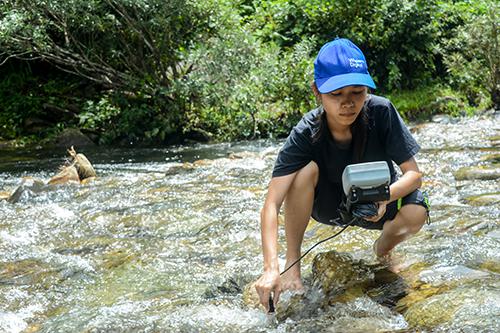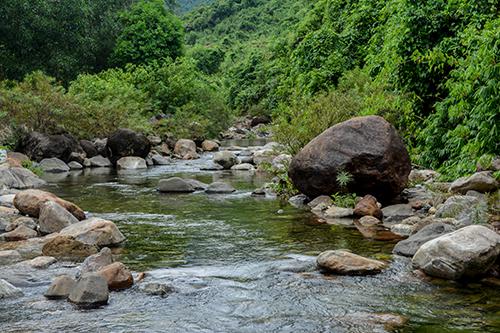Vo Thi Bich Thao
Yellow tail brook barb Poropuntius deauratus is one of the earliest described fish species in Vietnam since 1842. Due to uncertain taxonomy of P. deauratus, its distribution range has been determined unclearly. To conserve this species, our project will solve the problem in taxonomy of P. deauratus by molecular analysis to re-investigate its distribution. By the end of 2019, P. deauratus is going to be collected from coastal river drainages in Central Vietnam and identified by DNA barcoding combining with morphology approaches to determine the brook barb P. deauratus species. In the mid of 2020, distribution areas will be mapped from river drainages where they occur. The information on DNA sequences and distribution of P. deauratus will be published to GenBank, Boldsystem, www.fishbase.org and peer-reviewed journal as reference. The data from this study will assist the managers for its conservation.

Ms. Thao (project leader) measured water conditions of P. deauratus.
Yellow tail brook barb Poropuntius deauratus is one of the earliest described fish species in Vietnam since 1842 by Valenciennes. This barb is one of fishes occasionally marketed fresh as local food where they were recorded and sometimes seen in aquarium trade. This barb occurs in medium size and small rivers and streams, in clear water with rapid current. With adapt features in restricted habitats; brook barb P. deauratus is vulnerable to habitat’s changes caused by dam construction, water pollution, and overfishing (Freyhof 2011). Correspondingly, P. deauratus are assessed as Endangered on IUCN Red List. They occur in Central Vietnam only (Serov et al. 2006). However, in some studies, this species are recorded from Cambodia, Thailand (Rainboth 1996, Kottelat 2000), China, Laos (Baird et al. 1999) and Malaysia (Ng and Tan 1999, Shah et al. 2009). Is the distribution of P. deauratus precisely? Robert (1998) indicated that misidentification between P. deauratus and P. normani. Poropuntius deauratus was also described with differences of caudal-fin morphology (Valenciennes 1842, Rainboth 1996, Serov et al. 2006). Therefore, the study on taxonomy of P. deauratus is necessary to investigate precisely its distribution. This will assist to establish the protected areas for P. deauratus’ conservation.

Poropuntius deauratus’ habitat in Bach Ma National Park (Thừa Thiên - Huế province).
Poropuntius deauratus will be collected from river drainages in Central Vietnam, and compared with specimens from Thailand, Laos, and Cambodia. From 2019 to 2020, field surveys will be conducted in rainy and dry season. Project sites are streams and rivers where are high elevation and characteristic by lotic habitats include three types: pool, run, and riffle. Fish specimens will be collected directly by local fishermen and indirectly from local fish markets. The detail distribution information is collected including latitude, longitude, and ecological parameters where P. deauratus occurs. Specimens are identified by using taxonomic literatures combine with DNA barcoding.
The results of P. deauratus’ identification provide primary information to determine the correct species and distribution areas of P. deauratus in the wild. Distribution information will be disseminated to management and local people in the form of reports, maps, publications, posters, and workshops. Through the project, we expect to improve local community awareness and practices on the value of natural fish resources for this species and their habitats conservation. Distribution information will be published in conservation journal by English language provide to management, scientists to create highly conservation effect for this species in the Southeast Asia region.